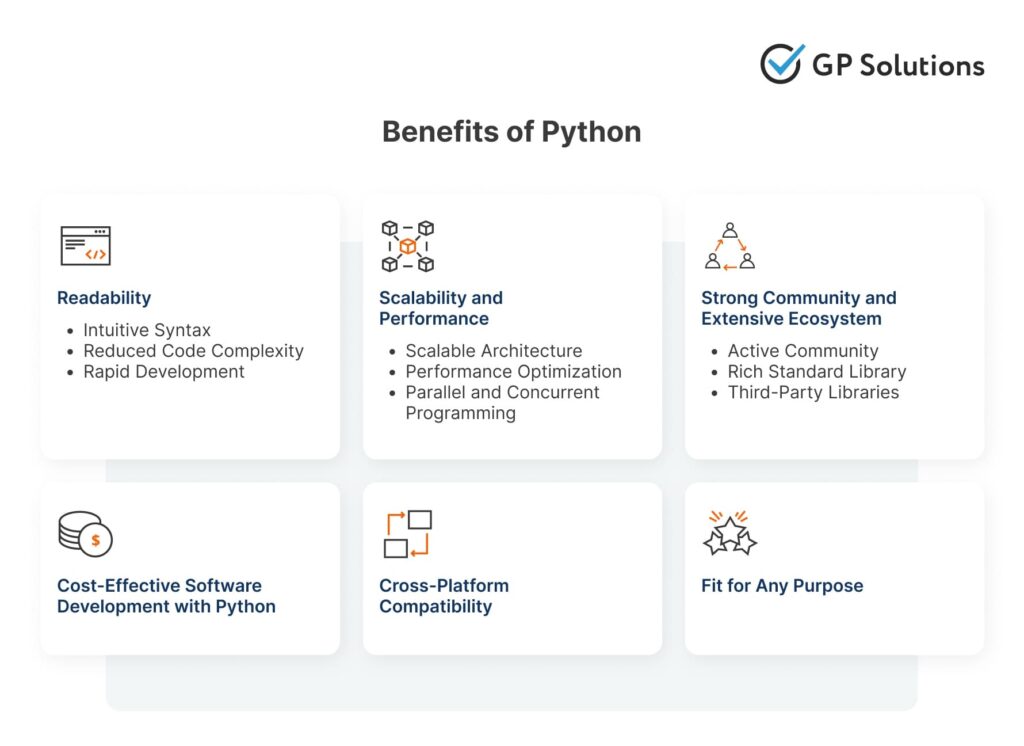The language of the snake first appeared over three (!) decades ago and rose to a notable position in programming, exceeding that of most other languages today. Software development with Python is cited as one of the frequently requested services by technology companies, who use it to power web applications, advance artificial intelligence, automate even the most complex repetitive tasks, as well as to drive impactful data science initiatives.
The TIOBE Index shows Python’s recent rise to the #1 top spot among programming languages, reflecting its consistent growth throughout the last decade. Can we position Python as a go-to tool for the future of technology? Has it reached its peak of popularity? Can we expect an imminent decline in the demand for Python software development, as is a common scenario with its competitors? In this article, we are going to answer these questions as well as take a brief look into the character of this language and investigate the reasons for its wide adoption.
The Rise of Python
Google trend line charts speak better than words. Judging from the tech giant’s data, Python overtook its rivals in mid-2019 to dominate the landscape, based on the number of inquiries.

Source: Google Trends.
Stack Overflow provides the same timeline when we can spot Python’s gaining power.

Source: Stack Overflow.
According to the same source, Python, JavaScript, and SQL were the most admired and desired languages in 2024, while GitHub’s data says it is now the number one choice language.
What’s the catch? The language would not enjoy such popularity were it not for its strong advantages. We suggest to briefly consider its powers that raised the language in the world.

Looking for a Python developer? Just tell us what you need!
Benefits of Python for Software Development

Readability and Simplicity
Python’s outstanding simplicity is, quite simply, one of its greatest strengths. The close resemblance of its clean syntax to natural English makes it suitable for novice programmers as well as those with prior experience of development. With Python, you achieve faster development cycles, since this clarity shortens the learning curve and reduces debugging time.
- Intuitive Syntax: Python’s design concentrates on a syntax closely resembling natural language, thus simplifying the writing, comprehension and maintenance of many programs.
- Reduced Code Complexity: Python allows software developers to achieve code clarity and error reduction in a few dozen lines, instead of hundreds of lines required by C++ or Java.
- Rapid Development: Python’s outstandingly simple design, along with its powerful libraries, speeds up development, thus allowing for a much faster time-to-market for software projects.
Scalability and Performance
- Scalable Architecture: Frameworks such as Django and Flask make the task of creating large-scale web application easier for Python developers, and a library such as asyncio is perfect for asynchronous programming in Python. All this results in highly scalable applications where efficiency is at core.
- Performance Optimization: Python is famous for techniques targeting performance like profiling (it discovers performance bottlenecks in code), code optimization (effective algorithms and data structures), and C extensions (when you combine C or C++ code for computationally demanding work).
- Parallel and Concurrent Programming: Python has built-in support for both parallel and concurrent programming paradigms that helps you make use of multicore processors and distributed systems in order to increase performance.
Strong Community and Extensive Ecosystem
- Active Community: Using trial and error, Python adherents contribute to the language’s growth and offer massive support, forming a large and active community that drives the language’s evolution. They do so via submitting improvements, reporting bugs, and creating open-source projects. Developers, regardless of skill, readily access tutorials, forums, and helpful Q&A platforms such as Stack Overflow to find solutions to issues in their software development with Python. Python’s incredibly dynamic and forward-thinking nature is secured by regular meetups, along with conferences such as PyCon, which substantially ease collaboration among Python developers.
- Rich Standard Library: If developers are seeking to decrease the reliance on external dependencies, they can resort to Python’s vast Standard Library, which includes modules for multiple common tasks. The library makes coding easier and reliable for file I/O operations, data serialization, internet protocols, and web service tools. os and shutil manage multiple system-level interactions, whereas json and csv parse easily multiple data formats. Comprehensive documentation assists developers to efficiently maximize the potential of the library.
- Third-Party Libraries: The Python Package Index (PyPI) houses a vast array of third-party libraries dedicated to accelerated development of versatile functionalities. Data science, machine learning, as well as scientific computing rely heavily on incredibly effective libraries such as NumPy, Pandas, Matplotlib, in addition to Scikit-learn. All these combined create ample room for rapid prototyping and experimentation on the process of software development with Python.

Source: PYPL.
Cost-Effective Software Development with Python
The language’s open-source nature lowers development costs, since if you engage Python for software development, you eliminate licensing fees and get access to an enormous ecosystem of numerous free libraries and frameworks. These resources enable Python engineers to speed up development, ease the requirements for creating solutions from scratch, as well as lower associated expenses. The Python community we’ve discussed above provides invaluable frequent updates, extensive support, along with a massive amount of documentation, thus minimizing the need for costly proprietary tools or highly specialized expertise. Startups, along with enterprises seeking to streamline their development budgets, find Python a nearly ideal language for their purpose.
Cross-Platform Compatibility
Write Once, Run Anywhere — that’s what you can expect when you choose Python for software development. The language is cross-platform and can be deployed across Windows, macOS, and Linux from a single code source. This characteristic is conducive to the reduction of development time and costs, so if you aim at multiple platforms, it can be the one you need.
Fit for Any Purpose
The latest Python Development Survey conducted by JetBrains in collaboration with the Python Software Foundation showcases that the language can be used for multiple purposes: data analysis, web development, machine learning, data engineering, DevOps, system administration, programming of web parsers, academic research, writing automated tests, game development, and so forth, with the primary use cases found in the areas as shown below.

Source: JetBrains.
This cornucopia of applications has so far solidified the firm standing of the language in the development world, with many use cases such as machine learning and data analysis being in high demand in content-heavy environments.
We are going to dive deeper into this issue in the chapter below, as we’ve covered so far the major benefits of software development with Python (present), and now it’s high time we start talking about its future.
Future of Python for Software Development
Works for Any Project
Flexibility makes Python suitable for virtually all domains, starting with simple website development and going on to high load enterprise systems. Some may even call it an “anything” language. Scientific computing tools such as Matplotlib, SciPy and SymPy, and other help make research and engineering possible. Just like that, Python can lift a lot of load from system administration tasks such as network automation, configuration management, and log analysis.
Python’s outstandingly smooth integration with multiple languages and systems perfectly suits enterprise environments. This guarantees complete compatibility with legacy systems and promotes innovation at the same time. We will cut down to the most revolutionary fields of the language’s application below.
Welcomed by Everyone
Python’s easy learning curve, coupled with its intuitive design, has made it extremely popular with novice programmers; however, these very features don’t even slightly restrict its powerful capabilities in large-scale enterprise applications. In fact, Python is a cornerstone for many of the world’s leading technology companies. It is one of the languages the biggies like Google, Facebook, Netflix, Dropbox, Amazon, NASA, IBM, Pixar, and Disney use for core workflows such as backend services, machine learning, and system monitoring. Further, with its widespread adoption, Python becomes an even more future-proofed programming language.
Python formed the entire basis of Google’s initial technology infrastructure, and many critical internal operations still rely on Python, even with its unprecedented growth. Since its earliest days, Netflix has used Python extensively, combining its widely used libraries with proprietary tools to guarantee the platform’s scalability, reliability, as well as performance. With all the key functionality like recommendation algorithms, traffic distribution, failover systems, and real time monitoring powered with Python, the platform owes much of its success to the language.
Python’s Usage by the Companies You Certainly Know

Web frameworks, big data processing, and security automation

Data capture, analysis, integrations, open-source agent

Back-end development, data learning, and workflow automation (track orders, plan routes, assign couriers)

Scalability, automation, AI, data management, build systems, app engines, search engines, and recommendation engines

Data science, back-end services, content distribution networks, and animation/VFX

Business logic and algorithm training processes

User experience enhancements and infrastructure automation, API development, data analytics, content moderation

CRM AI, business logic, scripting, data science, and machine learning

Web frameworks, development and maintenance of back-end infrastructure, machine learning, and scalability solutions

Scalability, flexibility, and machine learning applications
Artificial Intelligence, Machine Learning, and Data Science
AI burgeons the agenda of literally every conference, meetup, and forum as never before. Python, on its part, seems to be the perfect fit for the job.
NumPy, Pandas, Scikit-learn, TensorFlow, PyTorch — all of them power Python’s rise to the leading language for machine learning, data science, and artificial intelligence in general and take up the challenges of data manipulation, algorithm development, and the creation of many advanced AI models, including neural networks. We expect to witness more innovations in connection to AI developments, since Python’s frameworks are capable of simplifying many aspects of neural network design, natural language processing, and computer vision. The language is vividly far ahead of all other alternatives in these fields.

Source: Google Trends.
The demand for big data AI as well as machine learning solutions increases. This fuels Python’s growing popularity in many data-driven fields. The technology’s strong capacity for managing, processing, and mining truly massive datasets, using powerful tools such as PySpark and Dask, strengthens its preeminent position in the field of big data processing.
Since data scientists use Python to extract results from data, it is their language of choice because it has a wide variety of libraries that can be used to get them. Thumbnails of Pandas or NumPy libraries are additional developer tools to deal with large datasets, statistical analysis, and predictive models; while platforms like Jupyter Notebooks establish an interactive environment for data exploration and sharing.
These are just not trends, this is the common future the global tech community is witnessing, and Python is at the forefront of it.
Automation and Scripting
Its simplicity makes Python a prime choice for automation and scripting routines. As businesses zero in on efficiency through automation, Python will surely play an important role in creating tailored scripts to streamline repetitive processes — file management, system administration, along with web scraping. Growing adoption of DevOps methodologies, along with the integration of continuous integration/continuous deployment (CI/CD) pipelines, increases this demand.
Data Visualization
For a Python developer, there are plenty of Python visualization libraries on offer: Matplotlib, Seaborn, and Plotly are leveraged for generating graphic visuals that communicate meaningful insights. They provide solution owners and users with easy to use tools to create charts, graphs, and interactive plots for later use. This would do wonders for Python’s future.
Blockchain Development
Libraries such as PyCryptodome and pybitcointools, which simplify cryptographic operations as well as ease blockchain applications, back up Python’s role in blockchain app development.
The flexibility and value extended by Python powers across the many industries rely in no small part on Jupyter Notebooks, Google Colab, and Kaggle that offer interactive and collaborative environments to work with the data and models.
Embedded Systems
As a flexible language, Python is suitable to build prototype IoT solutions and intelligent apps. MicroPython and CircuitPython are lightweight implementations that are rapidly expanding how embedded systems interact with Python. Device and sensor control is a well suited task for Python, given its efficient operation in resource constrained environments. As IoT devices proliferate, this makes Python all the more present in embedded systems and IoT development.
Game Development
Python’s accessibility and simplicity led it to meaningful fame when many of the game developers, particularly, the independent game makers adopted Python aided with Pygame and Kivy, which allowed the creators to generate 2D and 3D games. A very solid platform, Pygame supplies a strong framework for game development, freeing the developer from having to struggle with countless minor technical details to focus on the most important thing: being original.
Non-Stop Evolution: Python 3.14 and Counting
One of the things that make Python great is its evolution. Python has come a far way since its inception, and the largest step was going from 1.x to 3, with the latest version at the time of writing being 3.14.
When Python 3 was designed, it was entirely intentional to make it backwards incompatible, in order to improve the language in key areas — efficiency, consistency, conciseness. This change eliminated some “language warts” (previously introduced features that cause disruption to modern code), but temporarily affected some third party tools and libraries. Yet, the tech community need to go through these challenges so that we will have a much more robust language in the future.
Python is a language that is constantly being changed by the Python Software Foundation (PSF) and the broader Python community, keeping up with modern developer needs in a way that stays true to the core tenets of simplicity and readability. Being able to adopt new programming paradigms and technologies, Python’s design guarantees its continuing practicality and flexibility, and therefore Python is progressively less risky for different applications.
What’s Coming in Python 3.14?

Libraries and Frameworks
Due to extensive libraries, frameworks and tools, the future of Python and its role in engineering has been solidified in the fields like machine learning, data analytics, visualization, natural language processing, and web development. This enables developers to build out complex behaviors without deep expertise for all of that technology.
Key Python Libraries and Toolkits
| Library/Toolkit | Description |
|---|---|
| TensorFlow | Google’s leading open-source machine learning library for developing and training models. |
| NumPy | The most widely used Python library for complex mathematical functions. |
| PyTorch | A fast-growing library for machine learning models, widely used in AI research. |
| SciPy | A library for scientific and technical computing, complementing NumPy. |
| NLTK | Natural Language Toolkit for working with the English language. |
| Django | Python’s most popular web framework for building secure, scalable web applications. |
| Flask | A lightweight web framework for developing minimalistic, yet powerful web apps. |
Python’s package manager, pip, supports these libraries as part of more than 200,000 packages that makes Python relevant and continuously growing.
Good for Junior
Python’s versatility, simplicity, and adoption are contributing to its popularity. Because of its ease of use, it is a favorite of beginners as well as experienced developers in multiple fields.
Python’s syntax is simple and easy to read so it is heavily used as a teaching tool, and for this reason, many educational institutions (both online and offline) teach computer science on Python, making it the most widely taught language. This early exposure to Python means that the next generation of developers will probably continue to use it once they graduate into professional careers.
Moreover, having the ability to run Python on Windows, macOS, Linux, and even embedded systems, it can be implemented in nearly any environment. As more languages like Java and C++ see a decline in popularity, Python has quickly wormed its way up there as a prime option for many companies, establishing its future-proof status.
Is Python Good for Software Development?
There is no such thing as “the future of coding”, there will always be loads of different programming languages, each with their strengths and weaknesses, and each will be used in a different way for different things. That said, Python’s destiny as a language is solid, owing to its suitability in areas such as AI and machine learning, its ease of use, and fast-growing community support.
From web development, to AI research to game design, Python is here to stay, and its usage is expanding. It’s simple enough for a beginner to get started with, but also has the force of powerful libraries and frameworks behind it, which makes it ideal for a more advanced developer. Additionally, since it is used by many tech giants and software companies, they as well as the education institutions have already invested thousands of work hours in Python and thus will not abandon a useful resource, but rather keep using it.


















